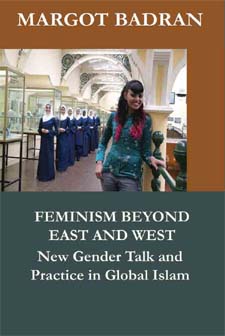Apr 14, 2025
Apr 14, 2025
 Is feminism Western? Is feminism compatible with Islam? Did Islamic feminism arise from within or from without? These are some questions that Margot Badran tries to respond to in her book 'Feminism Beyond East and West'.
Is feminism Western? Is feminism compatible with Islam? Did Islamic feminism arise from within or from without? These are some questions that Margot Badran tries to respond to in her book 'Feminism Beyond East and West'.
In a series of well argued and well crafted essays, Badran argues that feminism belongs to both East and West, transcends both, 'is produced in particular places' and 'articulated in local terms'. So in Muslim societies we have 'Islamic feminism' - a 'feminist discourse and practice articulated within an Islamic paradigm'. In the first couple of chapters, Badran introduces us to this brand of feminism, elaborating on its genesis and characteristics, at whose core is 'a re-reading of Islam's fundamental texts, the Qu'ran and the Sunnah (the Prophetic traditions)'.
Feminism in Egypt, to which Badran devotes maximum space, began well before the 20th century. Feminism in Egypt, culturally and militarily the most powerful country in the Arab world then, 'gained its initial entry into public space legitimized largely as a vital nationalist force'. So women decried 'the continued British colonial occupation' and demanded national independence in various ways.
The Egyptian Feminist Union also reached out to other Arab women, convened the Conference for the Defense of Palestine and spearheaded 'pan-Arab feminism' by creating the Arab Feminist Union that still exists today. Egyptian women even traveled to Italy to attend the International Woman Suffrage Alliance in 1923. Yet, after the 1952 Revolution, 'feminism was silenced'. The right to vote was granted to women only in 1956. Personal laws continued to be repressive, with major reforms coming in only 1985; the battle still continues.
Subsequent chapters deal with Muslim women's activism in countries not often associated with Islam - those of the Eastern bloc and Turkey, where religion was suppressed for a long time.
In Bosnia, young Muslims, not exposed to religion during their upbringing, found in Islamic feminism 'a path back to their lost religion and to cultural reconstruction'. So Amra Pandzo-Djuric, an activist in her 30s, interprets Islamic feminism to mean 'practicing Islam in an enlightened way'.
In Tajikistan, women who found themselves caught between local male religious leaders who wanted to re-impose a reactionary form of Islam and ex-Communists with a lingering antipathy to any new kind of religion, were trying to find a 'new Tajikistan' - interpreted as the 'recovery of a deeper indigenous cultural past evoking... dynamic, humanitarian Islam'.
The chapters on Turkey and Morocco give us a comprehensive overview of how family and personal laws have been revised, again because of women's activism, so that the new Turkish Civil Code of 2002 and the new Moroccan Mudawwana(Family Law) of 2004 'legalized the equal headship of the family by the two spouses'. While Turkey is a strictly secular country, Morocco's laws are Shariah-backed, and therein both countries can serve as examples of 'a synergy between the precepts of Islam and universal values' to corresponding states with Muslim communities.
'Going West Post- 9/11' is a delightful tongue-in-cheek review of Fatima Mernissi's book, "Scheherazade Goes West'. It reveals how Western stereotypes about Eastern women in 1923 'remain almost unchanged seven centuries later, as those by males in the West operating with fertile fantasies and inherited stereotypes'. Yet, "In the Orient, to use the body alone...sex without a brain, never helps a woman'. Sheherazade dialogued with the King; and dialogue is what Badran advocates.
 Badran understands that the path of Islamic feminism does not run smooth. The impediments are many, the enemies various. While there is the strange alliance between Muslim patriarchalists and Islamophobics, both of whom decry Islamic feminism (for different reasons), Islamists 'have tried to co-opt the discourse on women and gender in Islam' and have tried to de-secularize secular criminal laws in many Muslim countries.
Badran understands that the path of Islamic feminism does not run smooth. The impediments are many, the enemies various. While there is the strange alliance between Muslim patriarchalists and Islamophobics, both of whom decry Islamic feminism (for different reasons), Islamists 'have tried to co-opt the discourse on women and gender in Islam' and have tried to de-secularize secular criminal laws in many Muslim countries.
So in Nigeria, for example, we find Shariah-based statutory law. Badran narrates how two poor women convicted of the crime of 'zina' (adultery) are acquitted 'within the framework of Islamic argumentation' due to the activism of Nigerian women. Islamism, therefore, catalyzed Islamic feminism. Many Islamic feminists today insist not only on greater territorial space (as in the mosque movement), or equality in the private sphere, but also on governance by simply state laws rather than religious codes (like in Canada).
Finally, we come to Muslim women's activism in India. This chapter is disappointing. Muslim women in India have had a glorious past. Though a minority, Muslims in India constitute the world's second largest Muslim community. India is one of the few countries where Muslim women got universal suffrage without a struggle. There have been many leading Muslim women entrepreneurs and artists. Yet, Muslim personal laws remain repressive. Badran locates this and women's activism almost exclusively as a response to Hindutva (the right-wing brand of Hinduism), while the latter itself is located almost in a vacuum.
Compared to the chapter on Bulgaria (where Muslims constitute a minority too), Badran displays a certain lack of sensitivity in the chapter on India - both towards the Muslims and the majority community who live alongside them. Since it was written for a readership largely ignorant of South Asian history, the total silence on the 1947 Partition of India, which continues to shape the lives of million even today, is a glaring shortcoming for a scholar like Badran. It is hoped that in any future writing on Muslims in India, Badran will correct this oversight. Yet, the voices highlighted are interesting, considering they are not often heard.
Badran would also have done well to be more critical in her analysis of the 'Islamic feminist' paradigm. She repeatedly tells us how 'spirit of the Quran' enshrines gender equality, but does not substantiate this with quotes from the Quran. There are only references to some Quranic concepts. Yet, the author indicts Islamism and advocates secular laws so that the interests of non-Muslim women living in Muslim countries can also be taken on board. Badran's style is original, vividly descriptive and gripping. The many typos in the book mar an otherwise smooth reading of a text that serves as an excellent guide to women's activism in the Muslim world.
25-Aug-2007
More by : Aditi Bhaduri